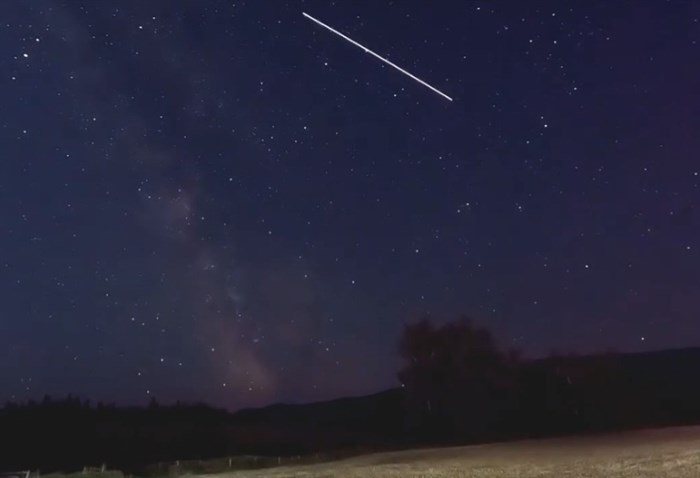
A Delta Aquariid meteor can be seen streaking across the night sky near Kamloops in a timelapse video taken on July 28.
Image Credit: SUBMITTED/ Lorie Cook
July 30, 2024 - 6:00 AM
A photographer in Cherry Creek near Kamloops captured a time lapse video of the Delta Aquariids meteor shower showing several brightly lit meteors streaking through a clear, starry sky.
Lorie Cook set up his recording equipment on July 28 away from light pollution and settled in to watch the show for several hours, later condensing it into a 15-second video.
“The night skies are amazing, you have to get out of the city to see the full effect of it,” he said. “There are times I’ll lay out there all night, it’s amazing to just sit and watch.”
The Delta Aquariid meteor shower merges with the famous Perseids meteor shower in the summer every year and there is still time to view them.
The Delta Aquariids can be seen from July 18 to August 21 and don’t have a noticeable peak, where an average of 15 to 20 meteors can be seen every hour. They are more visible in the southern hemisphere so viewers in the northern hemisphere require a dark night unobstructed by moonlight, according to EarthSky.org.
Lauded by NASA as the best meteor show of the year, the Perseids can be viewed from July 17 to August 24 with peak meteor activity on Aug. 12 where observers can see more than 100 meteors streak across the sky every hour.
READ MORE: iN PHOTOS: Supercars started their engines in Kelowna for Okanagan Dream Rally
The Delta Aquariid meteor shower’s parent comet comes from the 96P/Machholz Complex comet and appears to radiate from the constellation Aquarius. The Perseids are seen when Earth passes through ice and rock debris left by Comet Swift-Tuttle and appear to radiate from the constellation Perseus.
“The first time I saw the night sky I was a kid and I’ve always had an interest in it," Cook said. "If people got out of the city and were able to see the night sky better they’d be right into it.”
In the northern hemisphere, meteors are best viewed during the pre-dawn hours, but it is possible to see them as early as 10 p.m. Remember to find a spot with a wide view away from light pollution.
To contact a reporter for this story, email Shannon Ainslie or call 250-819-6089 or email the editor. You can also submit photos, videos or news tips to the newsroom and be entered to win a monthly prize draw.
We welcome your comments and opinions on our stories but play nice. We won't censor or delete comments unless they contain off-topic statements or links, unnecessary vulgarity, false facts, spam or obviously fake profiles. If you have any concerns about what you see in comments, email the editor in the link above. SUBSCRIBE to our awesome newsletter here.
News from © iNFOnews, 2024